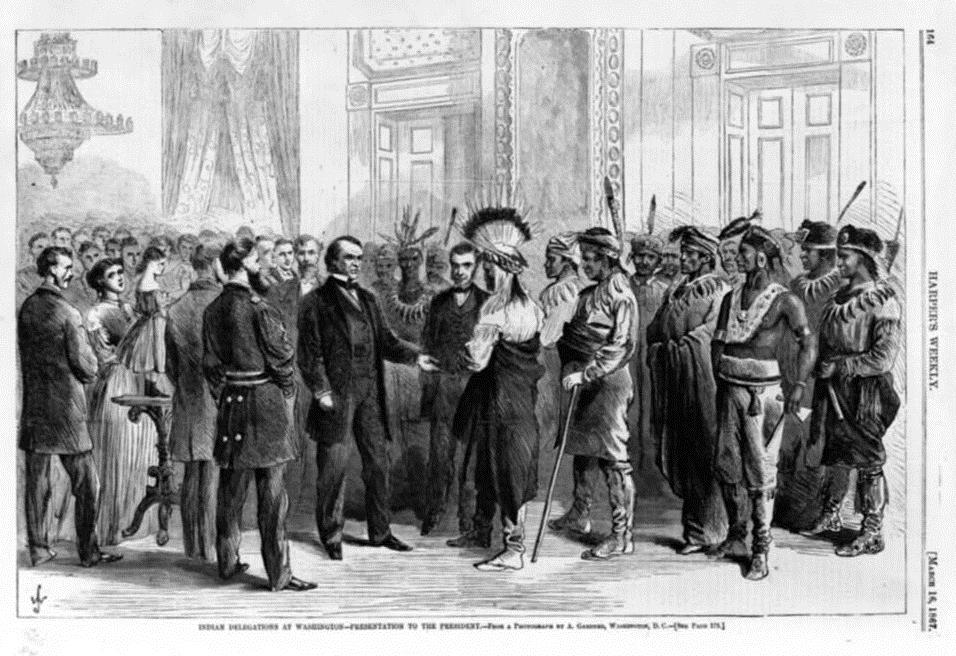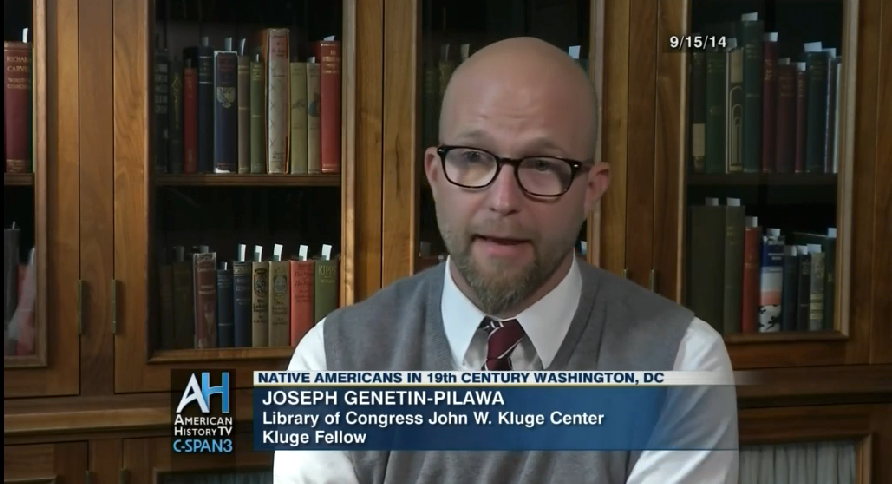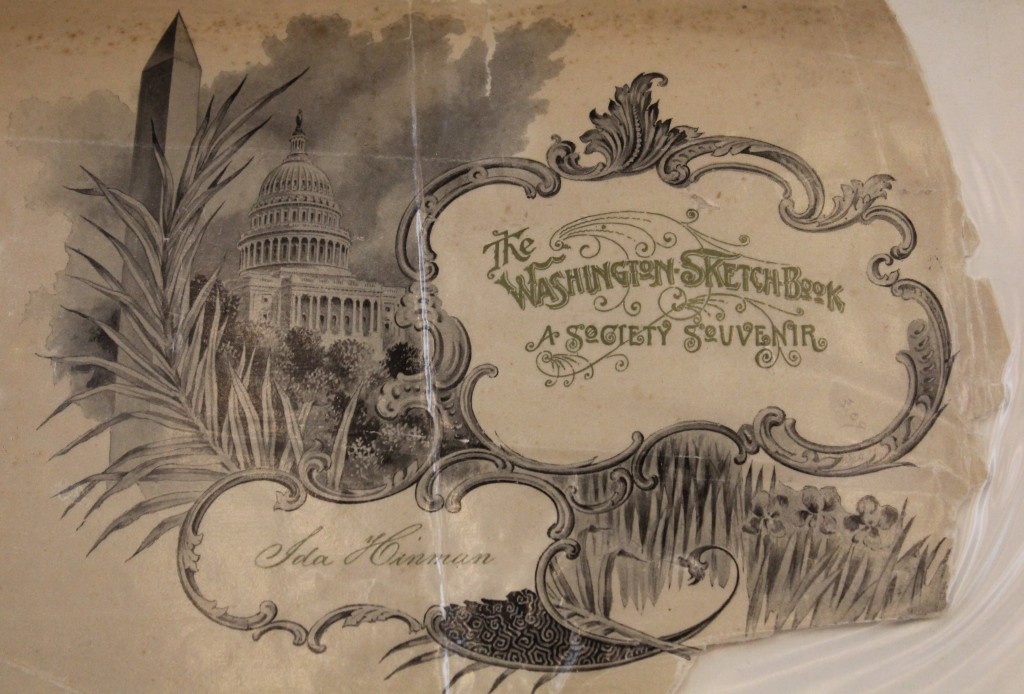Native Americans’ Capital City: Native Histories of Washington, D.C.
ANGLO AMERICA, 25 Dec 2017
Jason Steinhauer | Library of US Congress – TRANSCEND Media Service

Indian delegations at Washington–presentation to the president / From a photograph by A. Gardner, Washington, D.C. Harper’s Weekly, March 16, 1867.
Library of Congress Prints & Photographs Division, LC-USZ62-106694
As a Kluge Fellow at the Library of Congress, historian Joseph Genetin-Pilawa is researching his forthcoming book The Indians’ Capital City: ‘Secret’ Native Histories of Washington, D.C. He sat down with Jason Steinhauer to discuss the facts, myths, and contradictions of Native presence in the nation’s capital.
The Chesapeake has a rich indigenous history that predates the creation of Washington, D.C. What societies were here before the birth of modern-day Washington?
The human history of the region goes back thousands of years. Groups organized themselves into stratified political units known now as chiefdoms, developed military and political alliances, and practiced religious and spiritual ceremonies aimed at giving thanks and keeping the world in balance. They were all part of the massive Algonquian language that spanned the east coast, up through the Great Lakes and Canada, and even stretched to the Great Plains and part of present-day California. Although the distinct languages were related, they were not mutually intelligible.
The primary Native group that inhabited the area between the Potomac and Anacostia Rivers was and continues to be the Piscataway, along with several related groups, including the Anacostank, Pamunkey, Mattapanient, Nangemeick, and Tauxehent.
You’ve asserted that Native peoples played a significant role in shaping Washington, D.C. Can you elaborate on what you mean by that?
In my forthcoming book, I write about the perceived incongruity of Native people in urban spaces–that the Native past must give way to an urban future, and that they’re mutually exclusive. This incongruity is rooted in Washington, D.C. especially due to the creation of a commemorative landscape–centered in the art and architecture of federal buildings, but dispersed around the city as well–that iterated notions of pacification, of a conquest completed, and of vanishing Indians.
The artwork in the rotunda of the Capitol Building, for example, focuses on Native people assimilating (like Pocahontas), signing land treaties (William Penn and the Delaware), and being subjugated (Daniel Boone fighting Indians). My book argues that, unlike the Native subjects of capital art and architecture though, Indigenous visitors and inhabitants engaged with non-Native individuals and the symbols of settler society in Washington, carved out their own space(s) within it, and claimed or reclaimed an ownership of the place.
The presence of Natives in Washington in the first half of the 19th century coincided with removal of Native tribes from their homelands in the South and West. How do you interpret this tension between Natives being welcomed in Washington while Washington elected officials evicted Natives nationwide? Was that tension felt at the time?
That’s certainly a big part of what attracted me to this project. Much of the early artwork in the city was created and installed in the 1830s, ’40s, and ’50s, to support and justify the removal and reservation policies being simultaneously crafted by Congress and the Presidents. Yet, hundreds and thousands of Indian delegates were in the city concurrently. White Washingtonians told themselves one story on their walls and in their paintings, a story of a completed conquest and vanishing Indians, yet experienced an entirely different story in their everyday lives as they encountered actual Native people all over the city.
From the perspective of the Native visitors themselves, the tension was not so much about the representation versus the reality, but about resisting the very representations themselves. That process started in the earliest days of the city and continues to the present.
Watch: Joseph Genetin-Pilawa discusses his research on C-SPAN’s American History TV (click here)

Screenshot of interview with Joseph Genetin-Pilawa on C-SPAN3’s American History TV, September 15, 2014.
Source: http://www.c-span.org/video/?321524-5/discussion-native-americans-19th-century-washington-dc
Speaking of representations, you came to the Library excited to examine little-known 19th century guidebooks to Washington, which document Native people and places in the city. Can you tell us about what you’ve discovered? What did you find that you expected, and what surprised you?
The guidebooks have been great sources. These were written for Washington tourists and provided not only descriptions of the city, but also short anecdotes about capital society. Stories of Native delegates or inhabitants are sprinkled throughout the books.
One story, which was reprinted several times, was of the Winnebago (Ho-Chunk) delegation of 1837 and their visit to the Capitol Rotunda. The story originated in William Force’s Picture of Washington and its Vicinity. The Indians, he wrote, whose “faces were painted of various colors…[carried] their scalping knives and tomahawks, and …their long iron looking bows and arrows,” and examined the reliefs depicting scenes of colonization, but stopped in front of the relief showing Daniel Boone fighting and killing Indian men. They “looked intently for some moments, scrutinizing and recognizing every part of the scene…[and then] suddenly, as of one impulse, they raised their dreadful war-cry and ran hurriedly from the hall.” Force offered no explanation and his reader was left to wonder if perhaps the Indians could not distinguish between sandstone and flesh and were scared for their own lives, or if they ran out to avenge the deaths of the depicted Indians. His message was clear, though; Native people were not at home in the city.
Did this really happen? I’ve compared this story to newspaper accounts and personal reminiscences of the delegation, and I’ve seen nothing that indicates the Natives were violent or dangerous. In my book, I’m unpacking these stories as a way to explore how and why our cultural expectations develop, as well as how and why those expectations are challenged, resisted, and reshaped constantly.

Ida Hinman’s “The Washington Sketch Book: A Society Souvenir” (1895) was both a D.C. guidebook and social life manual. It was one of the few Washington guidebooks written by a woman.
From the Library of Congress collections.
And what about the customs manuals you’ve found, which also had surprising–and sultry–discoveries?
These sources have proved to be one of the most surprising, and exciting! Throughout the nineteenth century, white women wrote customs manuals and social life guides that chronicled events in elite circles of the capital. After the Civil War the number of these etiquette books written by or intended for women increased exponentially, suggesting women’s heightened importance in the capital as the nineteenth century rolled on.
I thought these sources might provide good insights into capital society. I did not expect that the women would be writing about Native men in the ways they did! Here’s an example: Ada Sterling, in “A Belle of the Fifties,” depicted a meeting between President Buchanan and a delegation of Native men she described as “the copper-hued sons of the Far West.” During the meeting, she said, “a young redskin sprang from the floor, where…he had been squatting. He was lithe and graceful as Longfellow’s dream of Hiawatha. The muscles of his upper body, bare of all drapery, glistened like burnished metal. His gesticulations were fierce and imperative, his voice strangely thrilling.”
Despite the fact that white women’s sexuality was closely monitored, it seems elite women of Washington very openly expressed desire, gazed in curiosity, and even gave voice to eroticized fantasies. In their writings and fantasies, Native men’s bodies became objects of desire in ways their other subjects did not.
There are many striking aspects to this project: uncovering a forgotten history, reclaiming a lost narrative, a better recognition of the diversity that came before us, revealing how we segregate Native history from urban history when in fact they are intertwined. What is your biggest takeaway?
My hope is that, in working to unpack the Indigenous histories of Washington, D.C., I can explore how and why our cultural expectations develop, as well as how and why those expectations are challenged, resisted, and reshaped constantly. If I do that well, the book will not only succeed in telling forgotten and “secret” stories about the capital, but make a larger contribution to how we think about the United States and its past.
__________________________________________
Joseph Genetin-Pilawa is Assistant Professor at George Mason University. His first book is Crooked Paths to Allotment: The Fight over Federal Indian Policy after the Civil War.
Go to Original – blogs.loc.gov
DISCLAIMER: The statements, views and opinions expressed in pieces republished here are solely those of the authors and do not necessarily represent those of TMS. In accordance with title 17 U.S.C. section 107, this material is distributed without profit to those who have expressed a prior interest in receiving the included information for research and educational purposes. TMS has no affiliation whatsoever with the originator of this article nor is TMS endorsed or sponsored by the originator. “GO TO ORIGINAL” links are provided as a convenience to our readers and allow for verification of authenticity. However, as originating pages are often updated by their originating host sites, the versions posted may not match the versions our readers view when clicking the “GO TO ORIGINAL” links. This site contains copyrighted material the use of which has not always been specifically authorized by the copyright owner. We are making such material available in our efforts to advance understanding of environmental, political, human rights, economic, democracy, scientific, and social justice issues, etc. We believe this constitutes a ‘fair use’ of any such copyrighted material as provided for in section 107 of the US Copyright Law. In accordance with Title 17 U.S.C. Section 107, the material on this site is distributed without profit to those who have expressed a prior interest in receiving the included information for research and educational purposes. For more information go to: http://www.law.cornell.edu/uscode/17/107.shtml. If you wish to use copyrighted material from this site for purposes of your own that go beyond ‘fair use’, you must obtain permission from the copyright owner.